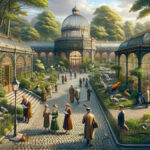Yellow berries
First, bananas are botanically classified as berries.
They are classified as such according to the inner seeds and the skin covered by the pulp, or the fruit itself.
Berries are easily recognisable if you think of blueberries, which are often characterised by their thin skin and fleshy fruit.
Grapes are also berries, as are tomatoes, peppers and aubergines. And bananas are also berries. From now on, we might as well call them yellow berries or white berries.
Incidentally, strawberries and raspberries are not called berries according to this scientific classification. It’s complicated.
Banana trivia collection Bananas not just yellow
Yellow bananas are common, but they are not only yellow in colour. There are bananas in red, pink, purple, striped and many other colours. They are so vivid that it looks as if they were Photoshopped. Incidentally, there are currently about 1,000 varieties of bananas in the world.
Also, bananas are not trees. They only look like trees because of their sturdy ‘trunk’.
Originating in South-East Asia, the banana is a plant that has travelled the world through human migration and trade and is now grown in more than 130 countries.
Nutritionally, bananas are rich in essential vitamins and minerals such as vitamin C, potassium and B6, and are also high in fibre, which can provide a range of health benefits from heart health to digestive health. Potassium in particular is synonymous with the nutritional benefits of bananas. There was even a scene in The Simpsons where they said they were deficient in potassium, so they had to make up for it with bananas.
This fruit is also popular with athletes because of its combination of sugar and potassium that is released quickly, which helps prevent muscle cramps
Historically, bananas have not always been eaten raw but prepared in various ways. In the Philippines, there is a dish where they are fried on skewers, which I actually ate myself and it was delicious. Other dishes include chips, wine and vinegar. Unripe green bananas are also used in curries.
Banana leaves are also a natural biodegradable dish. In South-East and South Asia, they can actually be found in restaurants.
Bananas are high in potassium and therefore slightly radioactive, e.g. potassium-40. Of course, this is not a concern and they are safe.
There is a threat of Panama disease. Panama disease is a fungal infection that has wiped out the previously dominant Gros Michel species and now endangers the Cavendish species.
These can be considered quite dangerous for monoculture farming. As an aside, in the past, wine grapes in France were also attacked by these diseases on a large scale. Surprisingly, there have been major plant incidents like this throughout history.
However, scientists are using CRISPR gene-editing technology to develop banana strains resistant to Panama disease and other threats in an attempt to counteract them. This is a sign of a counter-attack by mankind and the Fruit Coalition.
From seeded bananas to seedless bananas
Commercial bananas, especially the Cavendish variety, are monogenic, meaning they grow without fertilisation and are seedless.
Original wild bananas have many large, hard, watermelon-like seeds. This is in stark contrast to the seedless varieties we are used to.
The seedless banana came into existence only recently, between 8000 and 5000 years ago. The seedless, essentially vanishing mutant banana was propagated by humans through seedling cultivation using sprouts.
Incidentally, the Cavendish banana, which is the major banana in the world today, is a hybrid of two wild banana species, Musa acuminata and Musa balbisiana. Both of these wild bananas are actually hard and full of large seeds, but selective breeding has resulted in the nearly seedless variety we know today.
Remnants of this can be seen in bananas bought in supermarkets today. The black dots inside are remnants of seeds.
Why are bananas yellow? A. Because the green colour disappears
Bananas, like other plants, have chlorophyll, including green chlorophyll. This is why they are green initially.
As this ripens, chlorophyll catabolism occurs. The chlorophyll breaks down and the green colour becomes lighter. At the same time, the yellow pigment xanthophyll, which has always been present in bananas, becomes visible due to chlorophyll degradation.
In other words, the yellow banana is the result of the green colour becoming less green and more yellow.
Why do bananas turn black?
Banana skins turn black due to a process called enzymatic browning.
As the banana continues to ripen, an enzyme called polyphenol oxidase interacts with oxygen in the air.
This converts the phenolic compounds in the banana into melanin. This is how they turn dark brown or black.
In other words, it is the same melanin pigment that turns oxidised bananas black as the human sun protection mechanism.
As a side note, exposure to the phytohormone ethylene gas and wounds accelerate the speed at which bananas turn black.
This is because ripening and scarring weaken the cell walls and increase enzyme activity.
How can bananas be prolonged?
Stored in warm conditions, they ripen faster and turn black sooner. High humidity also causes ripening and blackening.
So if you are thinking of putting them in the refrigerator, you should not do that. The ripening will be delayed, but the peel will darken more quickly due to the low temperature damage to the peel.
Therefore, normal shade without heat is best.
However, avoid storing them with other fruit, such as apples, pears, melons or peaches. Ethylene gas is emitted and they ripen and turn black.
Putting them in the shade along the garden path? Avoid that too. If a car drives by, you’ll get exhaust fumes. And there is enough ethylene gas in it for the plants to react. (Leave aside the fact that you don’t want to be exposed to exhaust fumes in the first place.)
If you take care of the above, you should be able to keep them yellow for longer.
However, the best solution is to eat them as soon as possible, according to the story.



コメント